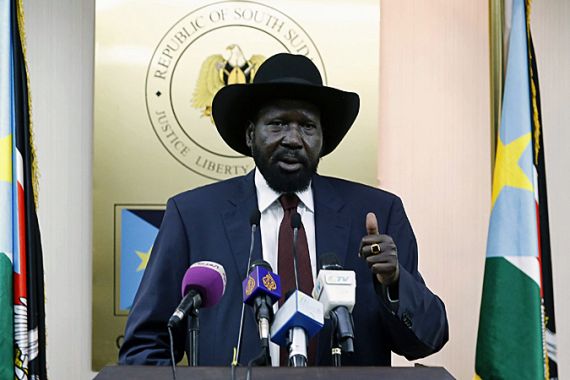Profile: President Salva Kiir
After decades in the military and politics, the man known for his cowboy hat became South Sudan’s first leader.

President Salva Kiir entered South Sudan’s top office in 2011 after decades spent first in the military, and then in politics, reaching a peak when the country gained independence from Sudan.
Kiir, from the Dinka tribe – the largest in South Sudan – was born in 1951 in the Bahr-el-Ghazal region of northwestern South Sudan.
He rose to the leadership of South Sudan’s ruling Sudan People’s Liberation Movement (SPLM) party and its army, the SPLA, in 2005, only three months after Juba had negotiated a peace deal with the Khartoum government to end one of Africa’s longest civil wars where hundreds of thousands lost their lives and millions were displaced.
The move was made possible after the founding leader, John Garang – a fellow Dinka – died in a helicopter crash.
An independent South Sudan was Kiir’s long cherished dream – far more so than Garang, who favoured greater rights for southerners in a united Sudan.
In 2005, Kiir said the choice was between either being a “second-class citizen in Sudan or a free person” in your own homeland, as he put in 2005.
The official website of South Sudan’s government compares him to “the Biblical Joshua who took the mantle of leadership from Moses just as the Israelites were on the verge of entering Canaan and capably established the then fugitives in the Promised Land”.
Tribal tensions
In order to make sure that Sudan upheld the peace treaty signed with Garang, Kiir took up the post of vice president in Sudan’s government.
South Sudan achieved independence six years later in July 2011 and Kiir became the president of the world’s newest country, having won elections a year before by a huge margin. There were allegations from the opposition of rigging and intimidation.
In July 2013, Kiir sacked his entire cabinet including his deputy, Riek Machar, in what many saw as tribal tensions and power struggle in the ruling party. Machar is from the Nuer tribe – the second largest tribe in South Sudan.
In mid-December, fighters loyal to Machar started fighting against South Sudan’s government troops. Kiir accused Machar of attempting a “coup”.
By the end of the month, the conflict had displaced tens of thousands of civilians and killed at least 1,000 people, raising fears of a return to civil war.
Machar accused Kiir of “dictatorial tendencies” early in December before the revolt. He said that Kiir had lost respect among the grassroots and failed to govern and develop South Sudan.
He also blamed Kiir for favouring the interests of the Dinka tribe.
Kiir, who is mostly seen in public with his trademark cowboy hat, is described in his official biography as “a teetotaller and non-smoker with remarkable military/political experience and qualities”.
He is considered to be a devout Christian and speaks regularly at the Roman Catholic cathedral in Juba.
Kiir first joined the southern rebellion in the late 1960s and reached the rank of an officer by the time Sudan’s President Jaafar Numeiri made peace with the rebels in 1972.
He joined the Sudanese army after the truce, but he switched sides as soon as the southern rebellion renewed in 1983 and rose to lead the rebel army, the military wing of SPLM that he helped Garang to form.